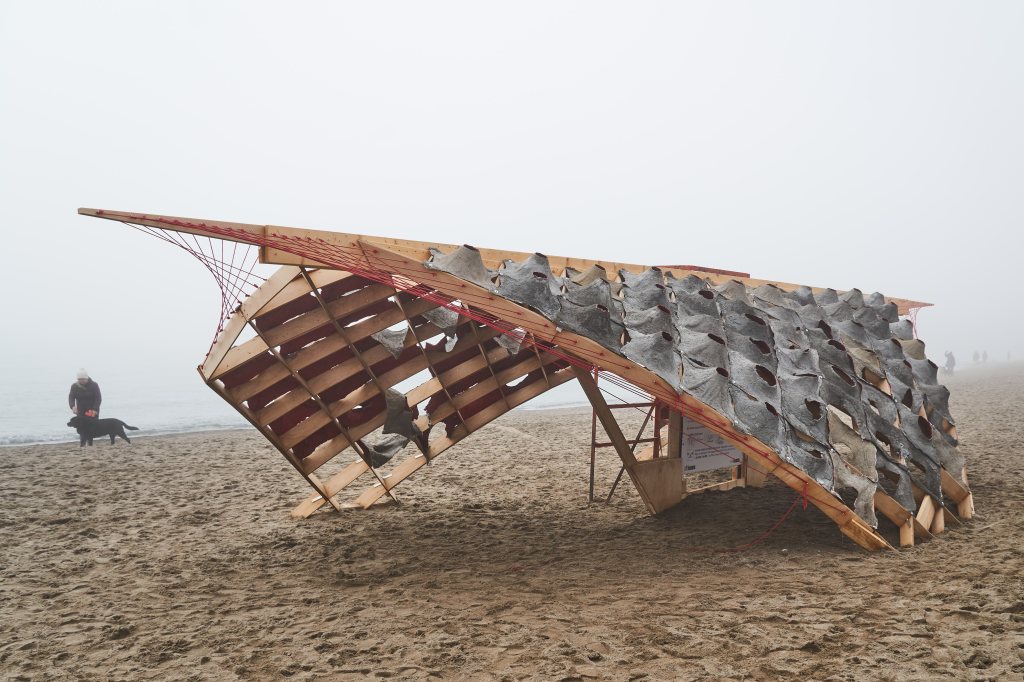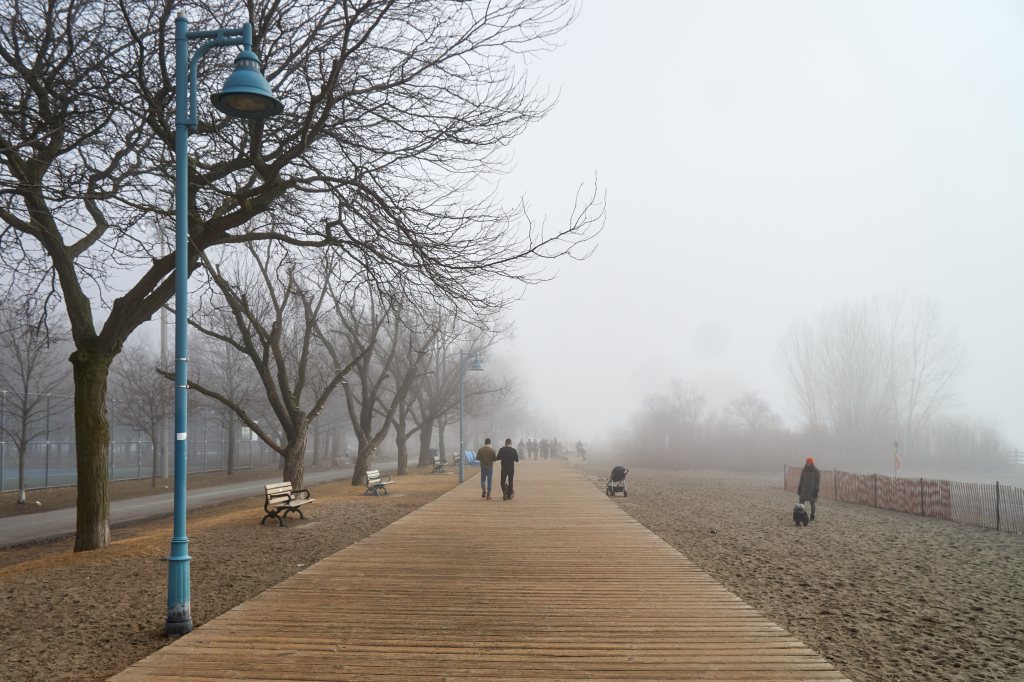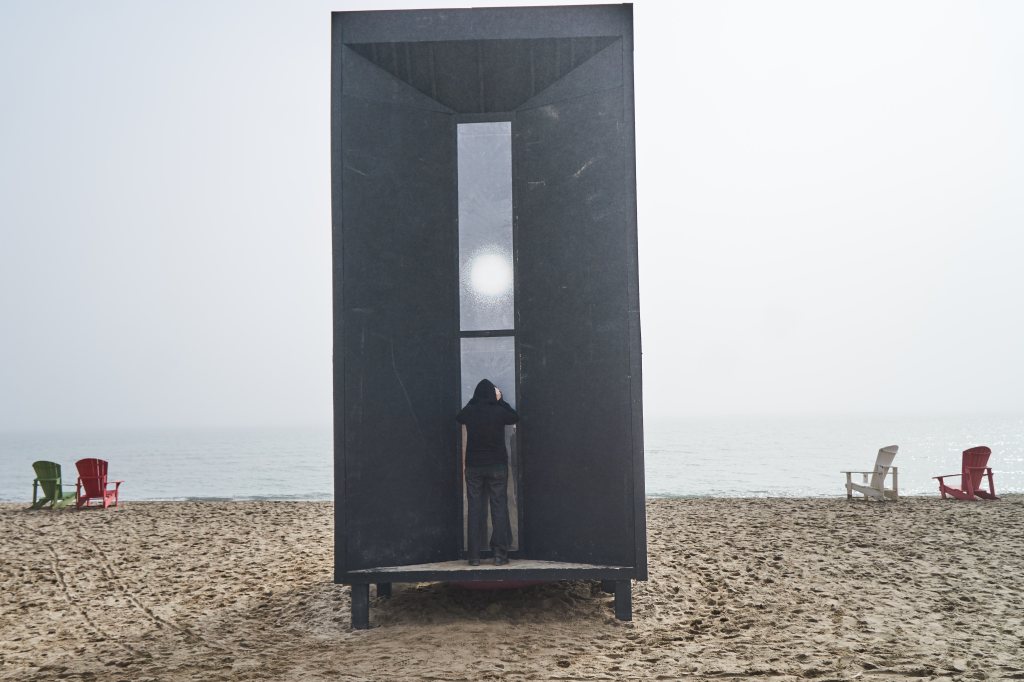Winter Stations is an annual international design competition where participants are assigned a common theme. This year’s theme is “resilience”, a reflection of our time during Covid.
Today, out from the fog, artistic displays were revealed to me as I walked along the shore of Woodbine Beach in Toronto, Canada. This has been the outdoor gallery for Winter Stations since 2015, not counting its absence during Covid.
As I approached each display, the fog seemed appropriate. It added an additional coming out of the “Covid fog” experiential element.
The atmosphere created by the fog, limited the visual depth of field available. It forced viewers to keep their attention on the contemplative designs.
A tiny community of strangers gathered together inside the fog bubbles share the experience of these interactive displays. Each one sits over existing lifeguard watch chairs. There’s an open side to each display, prompting visitors to take a seat in the tall lifeguard chair and look out through a narrowed observational perspective over Lake Ontario. On a clear day, participants can see winter swimmers, dogs fetching sticks from the chilly waters edge and people attempting to set personal best records skipping stones on the water’s surface. Unable to see clearly through this morning’s fog, the sound of water splashing, dogs barking and voices seem far away. Or are they? Fog tricks our senses.

The Hive
Resilience witnessed among communities in the face of challenging and unprecedented times is paralleled among the honey bee. Honeybee colonies are primarily composed of worker bees whose greatest measure of resilience is maintaining hive temperature throughout the cold winter months. This is achieved by adapting worker behaviour to use energy from stored honey to generate body heat within a tight hive cluster. The challenge of keeping the house warm is met by a colony level response – much like the collaborative community level response that is mounted in the face of adversity.
Text and Design Credit to Team: Kathleen Dogantzis & Will Cuthert (Canada)
The Installation is designed with a hexagonal structure reminiscent of a honeybee colony, and it highlights the colour variations of honey, which is the result of diverse floral resources. Individuals are welcome to experience the visual diversity of a Honey Bee hive and work together to form a collaborative community level hive cluster.

S’Winter Station
The forces of nature are relentless. Like the falling snow of the sky and the shifting sands of the beach, the pavilion embraces local winds, snow, and sun conditions. Following these directions of force, the pavilion’s wings embody movement by harnessing snow and mitigating strong winds. Beach towels have been formed into dynamic concrete panels with varying openings. These panels control the amount of light and snow allowed to enter, while also creating unique views outwards. Together the panels and wings protect users and encourage them to engage with their surroundings. Where the lifeguard station, beach towels, and marine ropes are more frequently used in the summer, the pavilion achieves resilience by employing these objects in the winter. The pavilion acts as a shelter for the community where winter conditions are celebrated by harnessing and adapting to natural forces.
Text and Design Credit to Team: Ryerson University’s Department of Architectural Science (Canada)

Wildlife Guard Chair
Woodbine Beach is a great place for recreation and an important area within Toronto’s ecological network. It is part of the cities natural heritage system, which ensures functioning habitats, thriving biodiversity, and assisting the quality of air, water, and Pollination.
Text and Design Credit to Team: Mickael Minghetti & Andres Jimenez Monge (France & Canada)
Among all the animals in this network, birds are the easiest to observe in winter. Some species permanently reside in Ontario, like the Northern Cardinal or Downy Woodpecker, and many more migrate here for the winter, like the Long-tailed duck. The site is a perfect spot to observe them!
From a distance, the station is designed as a sign for visitors. The station can be reassembled in other locations, and the red stained cladding is designed to be transformed into nesting boxes for the spring. Flying full circle!
As I continued along the foggy beach and having not yet reached the next installation in the time I expected, I realized I had lost my bearings. I was going in the wrong direction. There were three more displays, but they were behind me. Instead of making a 180 degree about face, I kept ambling forward.
The fog hadn’t really started to lift yet, and I couldn’t see for any appreciable distance ahead. By no means was I lost, but I had become distracted by the surprising little things I was coming upon at my feet.

The Kindness Rock Project
Who hasn’t seen these cutely painted little rocks? The Kindness Rock Project is where people paint small rocks, often with inspirational messages and leave them for others to find. The trend seems to have originated by Megan Murphy in 2015 on Cape Cod, an iconic beach resort area in the North Eastern United States. She wrote “You’ve got this” on a rock and left it on a beach.
In many places, beautifully painted rocks are frequently found, not only on beaches, but also beside busy sidewalks, front lawns and even in forests. Have you seen a Kindness Rock?

I looped back to restart my exploration of the Winter Stations. The boardwalk, a few hundred meters up from the shoreline made for an easier and more direct walk. However, I got side tracked again. I came upon an ice skating rink, in March. When almost all hints of winter have melted away; if only I had brought my ice skates!

The fog wasn’t near as dense as it was at the start of my morning day trip. Now approaching noon, visibility had increased greatly.

Introspection
In keeping with this year’s theme of resilience, we choose to base our design on the emotions felt throughout the past two years’ worth of quarantine and isolation. Playing with the idea of reflection, we utilize mirrored walls to cast the visitors as the subjects of our bright red pavilion, titled introspection. While the trellis roof allows the sun to eliminate the interior and its visitors the red lifeguard tower stands unyielding in the center of the pavilion, reminding us of the inherent stability within us. In highlighting the subjects presence, we hope to promote introspection into one’s own emotional resilience as one faces their own reflection. From afar, introspection appears to float on the beach’s horizon. Behaving like a visual constant in the wild, introspection and the lifeguard towers remind us that no matter what the worldwinds of life may bring, they endure it all and remain resilient to adversity.
Text and Design Credit to Team: University of Toronto John H. Daniels Faculty of Architecture, Landscape & Design (Canada)

Enter-Face
The times of pandemic have changed our habits in multi-scalar aspects, but it especially affected the way of how we perceive the world outside of us. More explicitly, it shifted our communication with people, interaction with the environment and the perception of our experiences by means of a single surface: the digital screen. Via offering the isolated a new version of coexistence, these screens not only made overcoming this challenging period possible but also became indissociably parts of lives as mobile “interfaces”. The project “Interface” aims to reveal the dramatic influence of these screens, therefore, presents a spatial atmosphere that brings people together by means of a common vision / image while isolating them physically. It proposes dark boxes with distant holes for people to get their upper body inside and stay detached from the other. Within the boxes, a textured transparent surface is placed through which the distant visitors, who became a group of viewers now, watch the life outside the box as if they are spectating never ending moving -image on a screen together.
Text and Design Credit to Team: MELT. Cemre Onerturk & Ege Cakir (Turkey)

One Canada
The Indigenous Peoples in Canada are an inspirational example of resilience due to their ability to withstand adversity and persevere through generations of oppressive colonial policies. Historic injustices persist, including the effects of cultural genocide from the residential school system of Canada. Here we symbolize bridging the gap between indigenous and non-Indigenous Peoples through gathering. Accomplished through the support of the seven grandfather teachings, represented by the seven rings of the installation, that originated with the Anishinaabe Peoples, passed down through generations that ensures the survival of all Indigenous peoples: Wisdom, Love, Respect, Bravery, Honesty, Humility, and Truths. Orange represents the National Day of Truth and Reconciliation, and the reality that the support of non-Indigenous Peoples, as Indigenous Peoples assert rights to self-determination, will strengthen relations and begin to redress the historic wrongs. Orange is displayed in the ropes where the pattern pays homage to the creation of drums, where the ropes were weave to honour culture. The installations flow towards the lifeguard stand reinforces the strengthening of the relationship and the protection of Canada hinges on the unity between peoples. We aim to symbolize movement to a new relationship, one based on mutual respect that honours Indigenous treaties and rights. The road forward is long and nonlinear, but we commit to take the journey together.
Text and Design Credit to Team: University of Guelph, School of Environmental Design & Rural Development (Canada)

Looks like Puddle Day is more fun than the Winter Stations. Is he pretending to be a giant wading through an ocean? He’s been in there for a long time, is he testing his boots for leaks? Credit to his mom for just letting him be himself and discovering his world on his own terms.
Wow, that was an interesting trip indeed. And I suspect I’d love the weather so much there, because it’s exactly what I enjoy—overcast and cold. Too bad I live in tropical Malaysia. What a good theme for this year too. Thanks for sharing!
LikeLike
Thanks Stuart, I didn’t expect fog but it certainly did make me change how was originally going to present this post.
LikeLike
I have seen a kindness stone on the Oakridges trail North ofToronto. Also one in the Hollidge tract of the York regional forest.
LikeLiked by 1 person
Thanks for sharing this. Very interesting. Anita
LikeLike